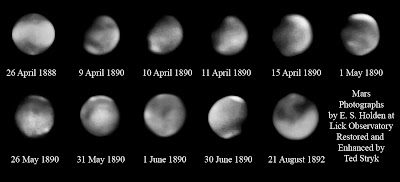Mars holds a special place in the history of planetary science. It is the only solid planet for which we have a long baseline of study that can be usefully compared with current observations. Venus is shrouded in clouds, meaning that the closest thing to actually seeing something prior to the use of ultraviolet photography consisted of faint, often illusory and always uninterpretable hints and dusky markings. Mercury is so close to the sun that most data obtained prior to the space age is of poor quality, and on an airless world like Mercury, there are no temporal phenomenon that visual observers could track. The Galilean satellites of Jupiter often show hints at detail in the eyepiece, but nothing more (at least nothing that could be understood without the aid of closeup data).
Then there is Mars. Clouds, dust storms, and surface changes have been watched by visual observers for over 300 years. At one time, the dark markings were thought to be oceans. White ice caps mark the poles. From the very beginning of the twentieth century through the present, there has been a consistent photographic and visual record which can be used to study the changing albedo patterns, the seasonal deposition and evaporation of material at the poles, dust storms, and clouds. In fact, we have a longer baseline of global imagery of Mars than we do of earth (although at very low resolution), since it wasn't until the 1960s that satellite imagery was available.
The 19th century was a transitional time. Telescopes were coming of age, and quality instruments were becoming more commonplace. Many quality drawings were made. These, along with more sporadic work from the previous centuries, have been used to try to reconstruct the history of regional and global dust storms (if many reliable observers recorded the same features being absent at the same time, and especially if they recorded an absence of detail while Mars was close, it is reasonable to assume a dust storm is the culprit). However, monitoring ordinary meteorological phenomena, the rate of expansion/evaporation of the polar caps, and changes in albedo features is nearly impossible from drawings, given the subjectivity involved. During the later part of the 19th century, some tracking of the polar caps was done using micrometers, but beyond that, visual observations are very difficult to use.
Mars was first photographed in 1877. I have never seen the images, but I am told they do not show any detail. The first quality images were taken by E. S. Holden using the 36-inch telescope at Lick Observatory between 1888 and 1892. He was never happy with the results, but they are impressive for the time. By 1890, he seemed to have some good results. However, in 1892, Mars had a declination far to the south, and as a result, the low position in the sky combined with the long exposures needed wrecked havoc, rendering most exposures useless. Additionally, film in those days was primarily sensitive to blue light. You will notice that clouds seem exaggerated as a result of this. Holden was angry at William Pickering, the director of Harvard Observatory (Lick Observatory was a part of Harvard Observatory), for using the images, which he felt were too poor to present when compared with the drawings of the day. For this and other reasons, Holden left Lick observatory and the project stopped. Pickering continued to use the images, and in many publications they are incorrectly attributed to him.
I applied some modern processing techniques to clean up some of the images. Because the film available to Pickering was highly sensitive to blue light and totally blind to red light, atmospheric features such as clouds appear exaggerated. Still, many familiar features can be seen. These images are especially remarkable given that the slow film speed required twenty minute exposures!
These images, obtained by Harvard Observatory/E.S. Holden, were processed and restored by Ted Stryk















































